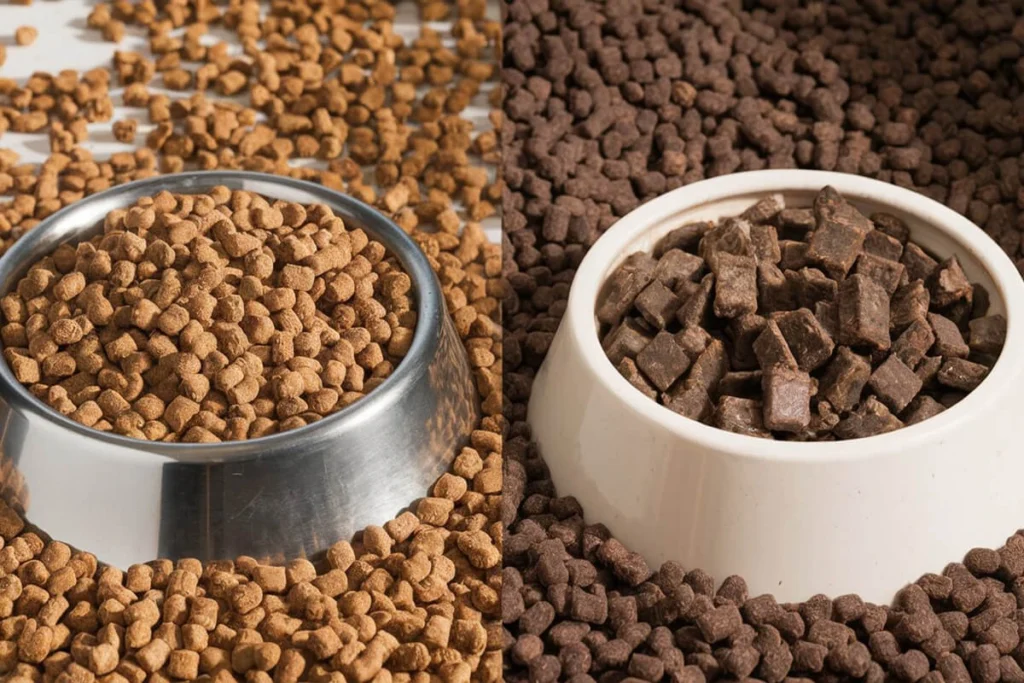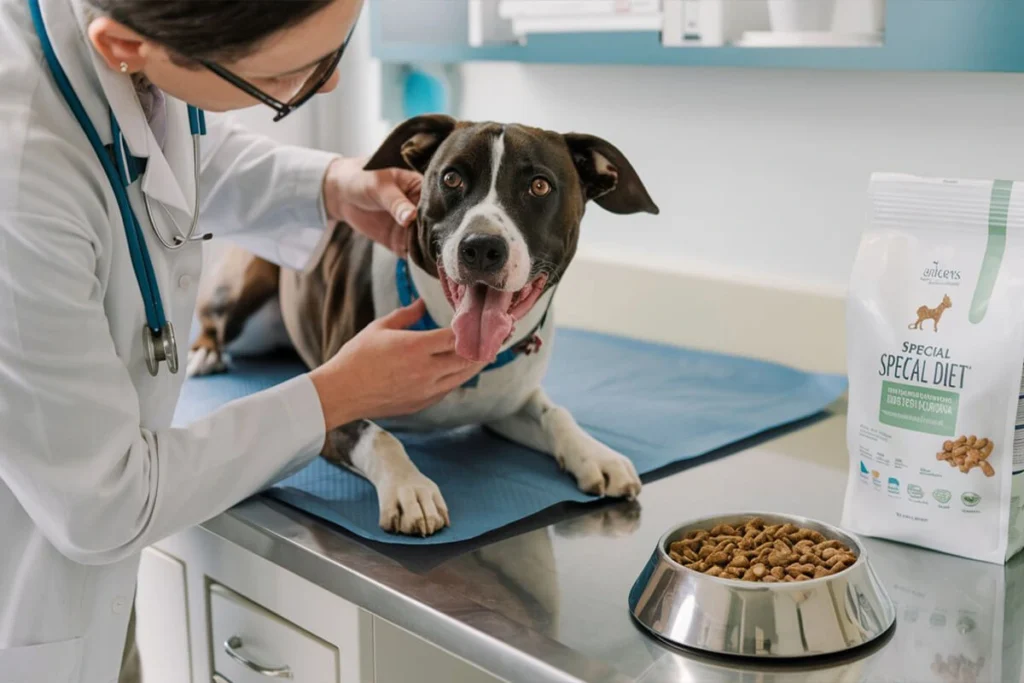Dogs bring joy, companionship, and unconditional love into our lives, so it’s only natural to want the best for them—starting with their diet. Wholesome dog food plays a crucial role in keeping your furry friend happy, healthy, and full of energy. A well-balanced diet supports strong muscles, a shiny coat, and a robust immune system. But with so many options on the market, from organic and grain-free choices to high-quality kibble and homemade recipes, choosing the right food can feel overwhelming.
Understanding what goes into your dog’s bowl is just as important as the ingredients you choose for yourself. The right nutrition fuels their body, aids digestion, and helps prevent common health issues like allergies, obesity, and digestive troubles. Whether you’re considering a holistic approach, looking for premium dog food brands, or exploring homemade meals, this guide will help you make informed choices.
In this article, we’ll break down everything you need to know about wholesome dog food—from key ingredients and nutritional benefits to choosing the right type of food based on your pup’s unique needs. Let’s dive in and explore how you can nourish your dog with the best diet possible!
Understanding Wholesome Dog Food
What Makes Dog Food “Wholesome”?
Wholesome dog food provides essential nutrients that support long-term health. It contains high-quality protein, healthy fats, fiber-rich carbohydrates, and vital vitamins and minerals. A good diet avoids artificial preservatives, fillers, and low-quality ingredients that can trigger allergies and digestive issues.
Whole food ingredients offer maximum nutritional benefits. Whole meats like chicken, beef, or salmon serve as excellent protein sources, supporting muscle growth and repair. Healthy fats from fish oil and flaxseed help maintain a shiny coat and promote brain function. Complex carbohydrates like sweet potatoes and quinoa provide steady energy without blood sugar spikes.
Many commercial dog foods include artificial flavors, colors, and preservatives. These additives may improve taste or extend shelf life, but they can contribute to allergies and long-term health problems. Choosing natural dog meals ensures your pup receives real, nutritious ingredients without unnecessary chemicals.
Some pet owners choose human-grade dog food for stricter quality standards. These foods use ingredients safe for human consumption, providing a higher level of safety and nutrition. While more expensive, they offer superior ingredient quality and fewer processed additives.
When selecting wholesome dog food, always check ingredient labels. Look for real, whole-food ingredients instead of vague terms like “meat by-products” or “animal meal”. Avoid excessive fillers like corn, wheat, or soy, as they add little nutritional value and may cause digestive issues. A wholesome diet ensures better energy, a stronger immune system, and improved overall health for your pup.
The Importance of a Balanced Pet Diet
Just like humans, dogs need a well-balanced diet to maintain optimal health, energy levels, and longevity. A balanced pet diet includes the right mix of protein, fats, carbohydrates, vitamins, and minerals to support various bodily functions. Without a proper balance, dogs may experience nutrient deficiencies, leading to weakened immune systems, poor coat quality, digestive issues, and an increased risk of chronic diseases.
Protein is one of the most important nutrients in a dog’s diet, as it helps build and repair tissues, support immune function, and maintain lean muscle mass. High-quality protein sources include chicken, beef, fish, turkey, and eggs. For dogs with allergies or sensitivities, novel proteins such as venison or duck can be excellent alternatives.
Healthy fats, including omega-3 and omega-6 fatty acids, play a crucial role in brain function, skin health, and joint support. These essential fats can be found in fish oil, flaxseed, and chicken fat. Carbohydrates, while often debated in dog nutrition, can provide valuable fiber and energy when sourced from whole foods like sweet potatoes, brown rice, and lentils.
Vitamins and minerals also contribute to a dog’s well-being. Calcium and phosphorus support strong bones and teeth, while antioxidants from fruits and vegetables help combat free radicals and strengthen the immune system. Probiotics and fiber aid digestion, ensuring a healthy gut microbiome that promotes nutrient absorption and reduces stomach discomfort.
Feeding your dog an unbalanced diet can lead to various health problems. A diet lacking in essential nutrients may cause lethargy, dull coat, weakened immune response, and long-term developmental issues. Conversely, overfeeding or providing too much of one nutrient can result in obesity, digestive disorders, or metabolic imbalances. By selecting wholesome dog food with a well-balanced nutritional profile, you ensure your pup receives everything they need to stay active, happy, and healthy.
AAFCO Dog Food Standards Explained
When shopping for dog food, you might notice labels stating that the food meets AAFCO standards—but what does that really mean? The Association of American Feed Control Officials (AAFCO) is responsible for setting nutritional guidelines that ensure pet food contains the essential nutrients required for dogs at different life stages, including puppies, adults, and seniors.
AAFCO does not directly test or regulate pet food, but it provides a framework that manufacturers follow to create nutritionally complete meals. If a product states that it meets AAFCO’s complete and balanced nutritional standards, it means the food has been formulated to provide the minimum required nutrients based on research and feeding trials.
However, not all AAFCO-compliant foods are created equal. While some brands go beyond the minimum requirements and use high-quality, whole-food ingredients, others rely on synthetic vitamins and poor-quality fillers to meet the standards artificially. Just because a dog food meets AAFCO guidelines does not guarantee it is the best choice for your pet.
Pet owners should still carefully analyze ingredient lists and look for high-quality protein sources, natural preservatives, and whole food ingredients. Understanding how to read dog food labels ensures that you are selecting not just an AAFCO-approved meal but a truly nutritious and wholesome diet for your furry friend.
Another important factor to consider is whether the food is labeled for a specific life stage. Puppies require more protein and calories for growth, while senior dogs may need fewer calories but higher levels of joint-supporting nutrients like glucosamine and chondroitin. Selecting food that meets AAFCO standards while also catering to your dog’s unique needs will help ensure they receive the best possible nutrition throughout their life.
Key Ingredients for a Healthy Dog Nutrition
Best Protein Sources for Dogs
Protein is essential for your dog’s muscle growth, immune health, and energy levels. The best protein sources come from whole, high-quality meats that provide essential amino acids. Chicken, beef, turkey, and lamb are some of the most common and nutritious options. Salmon and sardines offer not only protein but also omega-3 fatty acids, which improve coat health and brain function.

For dogs with allergies, novel proteins like venison, duck, rabbit, or bison can be excellent alternatives. These proteins are less likely to trigger food sensitivities while still providing essential nutrients. Eggs are another excellent protein source, rich in amino acids and easily digestible.
While some dog foods include plant-based proteins like peas, lentils, and chickpeas, these should complement, not replace, animal-based proteins. Dogs require specific amino acids found primarily in meat. Additionally, avoid dog foods that list “meat by-products” or “animal meal” as the primary protein source, as these can be lower in quality.
According to AAFCO standards, adult dogs need at least 18% protein, while puppies require 22% or more. A diet rich in high-quality protein supports lean muscle mass, strong bones, and a healthy immune system. Choosing the best protein sources ensures your dog stays active, strong, and thriving.
Essential Vitamins and Nutrients (Omega-3, Probiotics)
Dogs need essential vitamins and nutrients to support their immune system, digestion, and overall well-being. Omega-3 fatty acids, found in fish oil, flaxseed, and salmon, are crucial for brain function, joint health, and a shiny coat. These healthy fats also reduce inflammation and improve heart health.
Probiotics, found in yogurt, kefir, and some dog food formulas, support gut health by balancing beneficial bacteria. They help with digestion, improve nutrient absorption, and reduce stomach issues like bloating or diarrhea. Many high-quality dog foods now include probiotic strains like Lactobacillus and Bifidobacterium to aid digestion.
Other essential vitamins include Vitamin A (carrots, liver) for vision and immunity, Vitamin D (fish, eggs) for bone health, and Vitamin E (nuts, seeds) for skin and coat health. B vitamins from meat and leafy greens support metabolism and energy production. Minerals like calcium and phosphorus strengthen bones, while zinc and selenium boost immune function.
Ensuring your dog receives these essential nutrients from a balanced diet promotes long-term health, better digestion, and increased vitality.
Understanding Dog Food Ingredient Labels
Reading a dog food label is crucial for choosing a nutritious diet. The first few ingredients listed make up the majority of the food, so look for real meat sources like chicken, beef, salmon, or lamb as the primary ingredient. Avoid vague terms such as “meat by-products” or “animal meal,” which often contain low-quality leftovers.
Beware of fillers like corn, wheat, and soy, which provide little nutritional value and can contribute to allergies or digestive issues. Instead, choose foods with wholesome carbohydrates like sweet potatoes, brown rice, or lentils, which offer fiber and sustained energy.
Avoid artificial preservatives such as BHA, BHT, and ethoxyquin, which can be harmful over time. Instead, look for natural preservatives like mixed tocopherols (Vitamin E) or rosemary extract. Similarly, artificial colors and flavors should be avoided, as they serve no nutritional purpose.
The Guaranteed Analysis section provides details on protein, fat, fiber, and moisture content. AAFCO-approved foods meet minimum nutrient standards, but quality varies between brands. Always prioritize transparent labeling, real food ingredients, and balanced nutrition to ensure your dog gets the best diet possible.
Choosing the Right Type of Dog Food
Wet Food vs. Dry Kibble: Pros and Cons
Choosing between wet food and dry kibble depends on your dog’s health, preferences, and lifestyle. Wet food contains higher moisture content, making it beneficial for hydration and easier to chew, which is ideal for senior dogs or those with dental issues. It’s often more palatable, providing a richer taste and aroma that picky eaters enjoy. However, wet food can be more expensive, has a shorter shelf life once opened, and may lead to faster plaque buildup compared to kibble.

Dry kibble, on the other hand, is more affordable, convenient, and has a longer shelf life. The crunchy texture helps reduce plaque and tartar buildup, promoting better dental health. Kibble is also easier to store and portion out for feeding. However, some dogs find dry food less appealing, and it may not provide enough moisture, which can be a concern for dogs prone to dehydration or urinary issues.
A mixed diet can offer the benefits of both, providing variety, better hydration, and balanced nutrition. Some owners mix wet food with kibble to enhance flavor and texture while maintaining convenience and cost efficiency. Ultimately, the best choice depends on your dog’s specific dietary needs and preferences.
Grain-Free Dog Food vs. Traditional Options
Grain-free diets exclude corn, wheat, and soy, replacing them with alternative carbohydrate sources like sweet potatoes, lentils, or peas. This can be beneficial for dogs with grain allergies or sensitivities, helping reduce itching, digestive upset, and inflammation. Many grain-free options also use high-quality protein sources, making them a preferred choice for pet owners seeking a holistic dog diet.
However, traditional grain-based dog food provides essential fiber and nutrients from whole grains like brown rice, oats, and barley. Whole grains support digestion, offer sustained energy, and are a natural source of vitamins and minerals. While some dogs benefit from grain-free diets, there is no scientific evidence that grains are inherently harmful to all dogs. In fact, some grain-free diets have been linked to heart disease (dilated cardiomyopathy) in certain breeds due to an imbalance of essential nutrients.
The key is to focus on ingredient quality rather than just the presence or absence of grains. Whether grain-free or traditional, a wholesome diet should contain high-quality protein, essential vitamins, and digestible carbohydrates tailored to your dog’s needs.
Premium Dog Food vs. Budget-Friendly Choices
When it comes to dog food, price often reflects ingredient quality—but is expensive always better? Premium dog food brands use higher-quality protein sources, natural ingredients, and essential nutrients that support long-term health. Brands like Wellness, Blue Buffalo, and Orijen prioritize real meat, whole vegetables, and beneficial supplements like probiotics and omega-3s. These foods are typically free from artificial additives, fillers, and by-products, providing a more nutritious diet.
Budget-friendly dog food is more affordable but may rely on lower-quality ingredients, such as meat by-products, corn, and artificial preservatives. While these options meet AAFCO standards, they may not provide optimal nutrition, potentially leading to digestive issues, allergies, or nutrient deficiencies over time.
For pet owners on a budget, a good compromise is selecting mid-range brands that balance quality and affordability. Look for foods with real meat as the first ingredient, no artificial additives, and minimal fillers. Investing in better nutrition can lead to fewer vet bills and a longer, healthier life for your dog. Ultimately, the best choice depends on your budget, but always prioritize wholesome ingredients and balanced nutrition.
Homemade vs. Commercial Dog Food
Benefits and Risks of Homemade Dog Food Recipes
Many pet owners turn to wholesome dog food made at home to ensure quality ingredients and tailored nutrition for their pups. Homemade dog food allows full control over what goes into your dog’s diet, eliminating artificial preservatives, fillers, and by-products commonly found in commercial food. It can be particularly beneficial for dogs with allergies, sensitive stomachs, or specific dietary needs.

However, homemade diets come with risks. The biggest challenge is ensuring a balanced pet diet with the right amounts of protein, fats, carbohydrates, vitamins, and minerals. Without proper formulation, dogs may suffer from nutrient deficiencies, leading to serious health problems. Essential nutrients like calcium, phosphorus, and vitamin D are often lacking in homemade recipes, potentially affecting bone health and organ function.
To safely feed homemade meals, consult a veterinarian or a pet nutritionist. Recipes should follow AAFCO dog food standards and include a variety of high-quality protein sources, healthy fats, and digestible carbohydrates. Supplements like omega-3 fatty acids and probiotics may also be necessary for complete nutrition. While homemade dog food offers customization and freshness, it requires careful planning to avoid nutritional imbalances.
Human-Grade Dog Food: Is It Worth It?
Pet owners seeking wholesome dog food often consider human-grade dog food, which is made from ingredients fit for human consumption. Unlike traditional pet food, which may contain lower-quality by-products, human-grade dog food uses premium meats, whole vegetables, and natural preservatives, ensuring higher overall quality.
One of the biggest advantages is digestive health. Since human-grade food contains fewer artificial additives and more natural ingredients, dogs may experience improved digestion, fewer allergies, and a shinier coat. Additionally, many premium dog food brands offering human-grade options focus on high-quality kibble or wet food free from fillers like corn, wheat, and soy.
However, human-grade dog food tends to be more expensive and has a shorter shelf life due to fewer preservatives. While it provides a holistic dog diet, the cost may not be feasible for all pet owners. If affordability is a concern, consider a mix of premium and homemade meals to balance quality and budget. The key is ensuring a balanced pet diet that meets your dog’s nutritional needs while maintaining food safety and quality.
Best Dog Food Brands (Wellness, Blue Buffalo, Orijen)
Selecting wholesome dog food from trusted brands is essential for your pet’s health. Among the most recommended are Wellness, Blue Buffalo, and Orijen, known for their high-quality ingredients, balanced nutrition, and commitment to dog health.
Wellness focuses on natural dog meals made from real meat, wholesome grains, and superfoods like blueberries and spinach. Their formulas support dog digestive health, skin, and coat with added probiotics, omega-3s, and essential vitamins.
Blue Buffalo is known for its LifeSource Bits, a blend of antioxidants, vitamins, and minerals. Their recipes include grain-free dog food options, making them ideal for dogs with allergies or sensitivities. They prioritize real meat as the first ingredient, ensuring a high-quality kibble with no by-products.
Orijen is one of the most premium dog food brands, featuring biologically appropriate diets with fresh, regionally sourced ingredients. Their high-protein formulas use free-run poultry, wild-caught fish, and ranch-raised meats, closely mimicking a dog’s natural diet.
Each brand has unique benefits, but they all provide balanced pet diets that support longevity, energy, and overall well-being. Choosing the best option depends on your dog’s age, activity level, and dietary needs, ensuring they receive nutritious and wholesome dog food every day.
Special Diets for Dogs with Unique Needs
Dog Digestive Health and Sensitive Stomach Diets
Providing wholesome dog food is essential for maintaining a healthy digestive system, especially for dogs with sensitive stomachs. Digestive issues like bloating, diarrhea, and vomiting can often be linked to poor-quality ingredients, food intolerances, or imbalanced diets. A diet rich in easily digestible proteins, fiber, and probiotics can help support gut health and reduce discomfort.

High-quality protein sources like chicken, turkey, and fish are easier on the stomach compared to processed meats or by-products. Grain-free dog food may also benefit dogs with grain sensitivities, but it’s important to include alternative fiber sources like sweet potatoes, pumpkin, or brown rice to support digestion.
Probiotics and prebiotics play a crucial role in dog digestive health by promoting beneficial gut bacteria. Many premium dog food brands include Lactobacillus and Bifidobacterium, which aid in digestion and nutrient absorption. Additionally, omega-3 fatty acids help reduce inflammation in the digestive tract, benefiting dogs with chronic stomach issues.
For dogs with extreme sensitivities, limited-ingredient diets (LID) can help pinpoint triggers and eliminate allergens. These diets contain fewer components, focusing on one protein source and a simple carbohydrate, making digestion easier. Choosing the right balanced pet diet tailored to your dog’s digestive needs can significantly improve their overall well-being.
Dog Food Allergies and How to Handle Them
Many dogs suffer from food allergies, making it crucial to select wholesome dog food free from common allergens. Symptoms like itching, ear infections, excessive licking, and digestive issues may indicate an allergic reaction to certain ingredients. The most common culprits include beef, chicken, dairy, wheat, soy, and corn.
To identify food allergies, a limited-ingredient diet (LID) or an elimination diet is often recommended. This involves feeding a simple diet with one novel protein (such as duck, venison, or rabbit) and a single carbohydrate (like sweet potato or peas) to determine which ingredients trigger reactions. Once the allergen is identified, it should be permanently avoided.
Many premium dog food brands, such as Blue Buffalo and Wellness, offer allergy-friendly formulas with high-quality kibble that exclude artificial additives, fillers, and common allergens. Grain-free dog food may also help some dogs with gluten sensitivities, though not all food allergies stem from grains.
Supplements like probiotics, omega-3 fatty acids, and antioxidants can help strengthen the immune system and reduce inflammation caused by allergic reactions. Managing food allergies requires patience, careful ingredient selection, and consulting with a veterinarian to ensure your dog receives a balanced pet diet that meets their nutritional needs.
Holistic Dog Diet for Overall Well-Being
A wholesome dog food approach focuses on providing a holistic dog diet, which prioritizes natural, nutrient-rich ingredients that promote long-term health. A holistic diet includes high-quality protein sources, whole fruits and vegetables, essential fatty acids, and probiotics to support a dog’s immune system, digestion, skin, coat, and overall vitality.
High-quality animal proteins like grass-fed beef, free-range chicken, and wild-caught fish provide essential amino acids for muscle maintenance and energy. Adding superfoods like blueberries, kale, and turmeric can boost antioxidants and reduce inflammation. Probiotics and prebiotics help maintain a healthy gut microbiome, which is essential for nutrient absorption and digestive health.
Many holistic dog foods avoid artificial additives, fillers, and by-products, instead focusing on human-grade dog food standards. Brands like Orijen and Wellness create balanced pet diets that incorporate organic, sustainably sourced ingredients.
A holistic approach doesn’t mean just feeding premium dog food—it also involves proper hydration, regular exercise, and mental stimulation. By combining nutritious food, supplements, and a natural lifestyle, pet owners can ensure their dogs live longer, healthier, and happier lives.
Conclusion
Providing wholesome dog food is one of the most important ways to support your dog’s long-term health, energy levels, and happiness. A well-balanced diet filled with high-quality proteins, essential vitamins, healthy fats, and natural ingredients helps maintain strong muscles, a shiny coat, and a well-functioning digestive system. Whether you choose premium dog food, grain-free options, holistic dog diets, or homemade recipes, the key is ensuring that your pup receives the proper nutrients in every meal.
Understanding dog food ingredients allows you to make informed choices, avoiding fillers, artificial additives, and low-quality by-products that provide little nutritional value. Instead, look for real meat, wholesome vegetables, probiotics, and omega-3 fatty acids, all of which contribute to a balanced pet diet and better overall well-being. If your dog has food allergies, a sensitive stomach, or specific dietary needs, consider alternatives like limited-ingredient diets or human-grade dog food that focus on purity and digestibility.
The right diet varies for every dog, so paying attention to your pup’s unique needs, activity level, and health conditions is essential. Consulting with a veterinarian can also help determine the best food plan to keep your dog thriving.
At the end of the day, choosing wholesome dog food is an investment in your pet’s health and happiness. With the right nutrition, your furry friend will enjoy more energy, better digestion, and a longer, healthier life by your side.
Learn More about Dogs and Breeds From Here
Can Dogs Eat Marshmallow? Lets Find Out!
Find The Some Good Stuff For your Dog Here on PetMD Official

1 thought on “Wholesome Dog Food: Learn How to Nourish Your Lovely Pup”
Comments are closed.